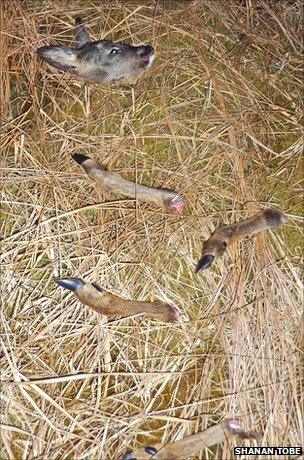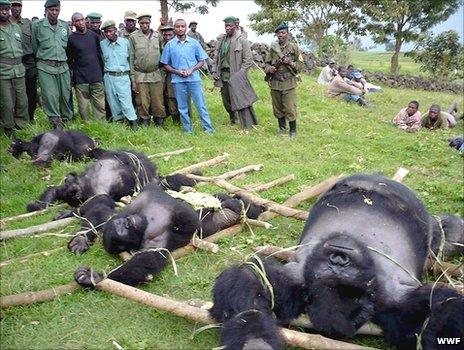Human DNA trap set for deer poachers
- Published

Poachers usually leave parts of the carcass behind - potentially bearing their DNA
Criminals who poach deer and other animals could be tracked through tiny samples of their DNA, researchers say.
Scientists in Scotland have shown it is possible to retrieve human DNA from the carcasses of dead animals in quantities that can identify the perpetrator.
Official figures suggest hundreds of deer are poached each year in the UK, but some say the number is much higher.
Potentially the technique could be used in other countries to identify rhinoceros or elephant poachers.
The research is in press in the journal Science and Justice, external, but not everyone is convinced that the method is reliable or cheap enough for prime time use.
The idea originated with James Govan, a forensic scientist with the Scottish Police Services Authority (SPSA).
He was looking for a way of combating the poisoning of birds of prey.
About 30 raptors are killed each year in Scotland, according to official figures - though again, that could be the tip of the iceberg.
"It's a horrendous problem, and nobody quite knows who's doing it or why," he told BBC News.
"Sometimes farmers are blamed, sometimes gamekeepers are blamed - but I associate with quite a few gamekeepers and most of them detest it, so it's a mystery."
'Good match'
Mr Govan took his idea to the Centre for Forensic Science at the University of Strathclyde in Glasgow.
Researchers there decided to begin with deer, mainly because they thought the chances of obtaining workable human DNA samples would be better.
Typically, deer poachers remove parts of the dead animal including the head, lower limbs and gut - and in doing so, they must press the carcass, potentially leaving behind skin cells from their fingers, or segments of DNA that have been squeezed out from skin cells.
The researchers worked with 10 deer that had been legally culled, with the body parts removed.
Samples of DNA from the volunteers who had done the culling were obtained from all 10 animals, although the quality varied; all were put through a process known as amplification, which boosts the amount of material present to the point that it can be analysed.
"We're getting different results based on the different volunteers; but we are getting samples giving a high enough match that they'd provide compelling evidence," said lead researcher Shanan Tobe.
"There would be enough of the DNA profile often to get a match."
Some samples were so highly mixed with deer DNA, or present in such small amounts, that the amplification might not have allowed the people doing the culling to be identified reliably.
But two of the samples were good enough to identify to an accuracy of one in a billion people; a further two yielded one in a million identification.
The team is now refining the method in order to obtain better samples and so offer a better chance of identification and conviction.
Stronger samples should also make the processing cheaper - down from about £500-1,000 a time to £100-200.

Touch DNA could prove useful against poaching of animals such as gorillas
Not everyone is convinced that this "touch DNA" technique will prove viable.
Rob Ogden, a wildlife forensic scientist with the Trace network, believes there might be more efficient ways of spending the available money.
"It sounds like a neat idea; but from a practical perspective, human touch DNA is still extremely difficult, the success rate is low and where it is successful it tends to be on samples that are not out in the environment," he told BBC News.
"When you've got a wildlife crime carcass, you'd be better off looking at DNA of the deer, linking that back to samples of blood on implements that had been used."
Although deer poaching is rising in the UK, from a global perspective the illegal killing of animals such as rhinos, tigers and chimpanzees is a much bigger problem, potentially bringing species to extinction.
Dr Tobe believes the technique he has developed would probably work better in warmer, drier parts of the world such as the African savannah, because DNA on carcasses should remain intact for longer before breaking down.
However, use here might be compromised by the limited availability of databases containing DNA records from convicted or suspected criminals.
Back in Scotland, James Govan anticipates the day when he can use the new technique to bring and win a case.
"It's only a matter of time before there's a criminal prosecution on this," he said.
Follow Richard on Twitter, external
- Published11 July 2011
- Published1 June 2011